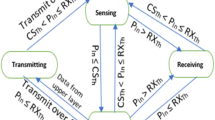Abstract
Without considering current residual resources of the medium, nodes in mobile ad hoc networks (MANETs) admit the data flow arbitrarily, and the quality of service (QoS) of the data flows deteriorates. To release the contending on the resources induced by the overloaded flows, the admission control mechanism can effectively keep the balance between injected data flows and network capacity, and it is viewed as the most important technology in MANET. A novel distributed residual resources aware admission control mechanism is proposed in this paper, where the residual resources and the service rate are studied thoroughly. Considering the medium utilization, frame retransmission and backoff procedure, the passive method is applied to predict the residual resources, and the binomial distribution is utilized to model the medium status; moreover, based on the cooperation between the source node and intermediate nodes, the path meeting the resource demand is probed across the network, and the flows are rejected while the residual resources cannot meet its demand. Results show that the network load can be constrained by our proposed admission control mechanism, and the QoS of the data flows can be guaranteed effectively.












Similar content being viewed by others
References
Ping CN, Soung CL (2007) Throughput analysis of IEEE802.11 Multi-Hop Ad Hoc networks. IEEE/ACM Trans Networking 15(2):309–322
Chi MA, Yuanyuan YANG (2011) A battery-aware scheme for routing in wireless ad hoc networks. IEEE Trans Veh Technol 60(8):3919–3932
Aggelou G, Tafazolli R (1999) RDMAR: A bandwidth-efficient routing protocol for mobile Ad Hoc networks. Proc. 2nd ACM Int. Workshop on Wireless Mobile Multimedia Workshop, Sept. Washington D.C, America
Cardieri P (2010) Modeling interference in wireless ad hoc networks. IEEE Commun Surv Tutor 12(4):551–572
Liu ZJ, Zhao WJ, Li Y et al (2004) Flow based QoS routing in ad hoc network. J Commun 25(12):125–130
Liu Y, Assi C, Agarwal A (2006) Enhanced per-flow admission control and QoS provisioning in IEEE 802.11e Wireless LANs. IEEE Globecom
Valaee S, Li B (2002) Distributed call admission control for ad hoc networks. Proc. VTC Fall, Vancouver, BC, Canada, pp 1244–1248
Ayyagari D, Ephremides A (1999) Admission control with priorities: approaches for multi-rate wireless systems. Mob Netw Appl 4:209–218
Ahn G, Campbell AT, Veres A, Sun L (2002) SWAN: service differentiation in stateless wireless Ad Hoc networks. In: Proc. IEEE INFOCOM 2002, New York, USA, pp 457–466
Lee SB, Ahn GS, Zhang X, Campbell AT (2000) INSIGNIAL: an IP-based quality of service framework for mobile ad hoc networks. Journal on Parallel Distributed Computing: 374–406
Yang YL, Kravets R (2005) Contention aware admission control for Ad Hoc networks. IEEE Trans Mob Comput 4(4):363–377
Chen L, Heinzelman, Wendi B (2005) QoS-aware routing based on bandwidth estimation for mobile ad hoc networks. IEEE J Sel Areas Commun 23(2):561–572
Zhao H, Garcia-Palacios E (2009) Rethinking available bandwidth estimation in IEEE 802.11-based ad hoc networks. Electron Lett 45(4):211–213
Cheikh S, Claude C, Guillaume C et al (2008) Bandwidth estimation for IEEE 802.11-based ad hoc networks. IEEE Trans Mob Comput 7(10):1228–1241
Kim TS, Yang Y, Hou JC, Krishnamurthy SV (2009) Joint resource Allocation and Admission Control in Wireless Mesh Networks. 7th International Symposium on Modeling and Optimization in Mobile, Ad Hoc, and Wireless Networks, WiOpt, Seoul, Korea, pp 1–10
Renesse R, Friderikos V, Aghvami H (2007) Cross-layer cooperation for accurate admission control decisions in mobile ad hoc networks. IET Commun 1(4):577–586
Nguyen T, Nguyen K, He LH (2008) Collaborative distributed admission control (CDAC) for wireless ad hoc networks. Wirel Pers Commun 47(2):1–21
Akbarzadeh S, Cottatellucci L, Altman E, Bonnet C (2009) Distributed communication control mechanisms for ad hoc networks. IEEE International Conference on Communications, ICC, Dresden, Germany, pp 1–6
Abdrabou A, Zhuang WH (2008) Stochastic delay guarantees and statistical call admission control for IEEE 802.11 single-hop ad hoc networks. IEEE Trans Wirel Commun 7(10):3972–3981
Hamdaoui B, Ramanathan P (2007) A cross-layer admission control framework for wireless ad-hoc networks using multiple antennas. IEEE Trans Wirel Commun 6(11):4014–4024
Zheng Y, Lu K, Wu D et al (2005) Performance analysis of IEEE 802.11 DCF in binary symmetric channels. In: Proc. IEEE GLOBECOM 2005, Missouri, USA, pp 3144–3148
Engelstad P, Sterb O (2006) Analysis of the total delay of IEEE 802.11e EDCA and 802.11 DCF. In: Proc. IEEE ICC, Istanbul, TURKEY
Liu J, Niu ZS (2008) Analytic model for IEEE 802.11e EDCA for unsaturated conditions. J Tsinghua Univ (Sci Technol) 48(4):498–501
Tickoo O, Sikdar B (2004) Queueing analysis and delay mitigation in IEEE 802.11 random access MAC based wireless networks. In: Proc. INFOCOM 2004, Hong Kong, CHINA pp 1404–1413
Tickoo O, Sikdar B (2004) A queuing model for finite load IEEE 802.11 random access MAC. In: Proc. ICC 2004, Paris, FRANCE, pp 175–179
Zhai H, Kwon Y, Fang Y (2004) Performance analysis of IEEE 802.11 MAC protocols in wireless LANs. Wirel Commun Mob Comput 4(8):917–931
Pham P, Perreau S, Jayasuriya A (2005) New cross-layer design approach to ad hoc networks under Rayleigh fading. IEEE J Sel Areas Commun 23(1):28–39
Hsu J (1974) Buffer behavior with Poisson arrivals and geometric output processes. IEEE Trans Commun 22(12):1940–1941
Abdrabou A, Zhuang WH (2008) Service time approximation in IEEE 802.11 single-hop ad hoc networks. IEEE Trans Wirel Commun 7(1):305–313
Acknowledgments
This work is supported in part by the National Natural Science Foundation of China (60972069, 61001105, 61102151, 61271261).
Author information
Authors and Affiliations
Corresponding author
Rights and permissions
About this article
Cite this article
Wu, D., Zhang, P. & Wang, R. Residual resources aware distributed admission control mechanism in mobile multi-hop network. Ann. Telecommun. 68, 553–568 (2013). https://doi.org/10.1007/s12243-012-0343-6
Received:
Accepted:
Published:
Issue Date:
DOI: https://doi.org/10.1007/s12243-012-0343-6




